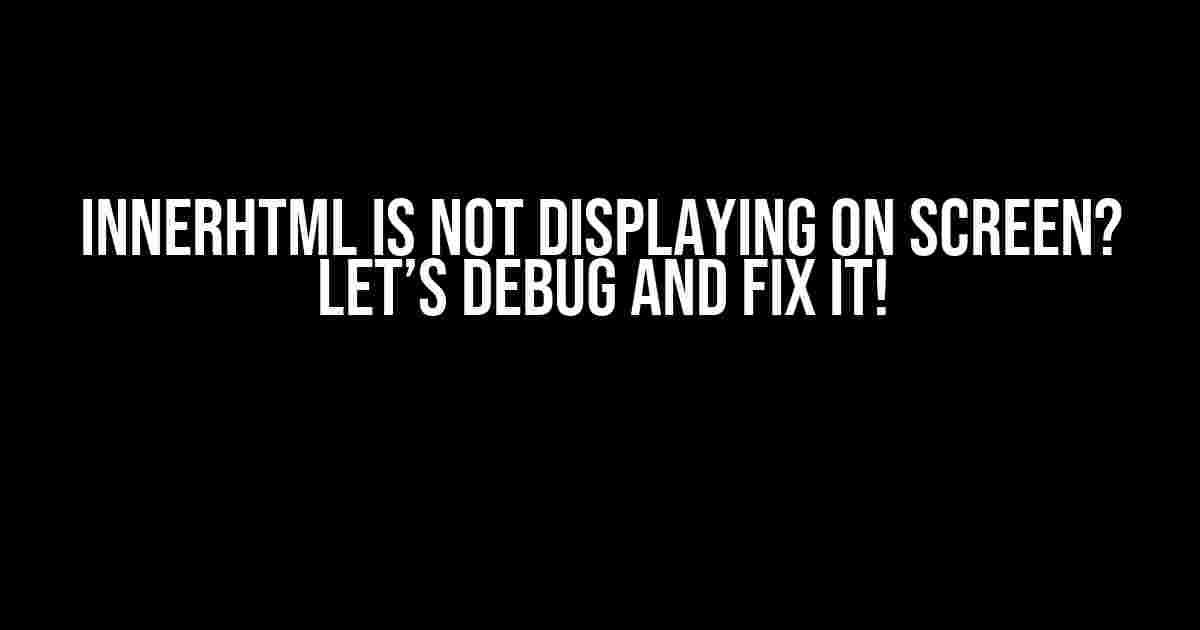Are you frustrated with your InnerHtml not displaying on the screen? Don’t worry, you’re not alone! Many developers have faced this issue, and it’s more common than you think. In this article, we’ll take a deep dive into the world of InnerHtml, identify the common pitfalls, and provide you with step-by-step solutions to get your content displayed on the screen.
What is InnerHtml?
Before we dive into the troubleshooting process, let’s quickly understand what InnerHtml is. InnerHtml is a property of the HTMLElement object that allows you to set or retrieve the HTML content of an element. It’s a powerful tool for dynamically updating the content of an HTML element, making it a crucial part of web development.
Common Scenarios Where InnerHtml Fails to Display
InnerHtml can fail to display on the screen due to various reasons. Here are some common scenarios where this might happen:
- The element is not properly referenced in the JavaScript code.
- The HTML content is not properly formatted or is malformed.
- The element is not visible or is hidden due to CSS styles.
- JavaScript errors or exceptions prevent the InnerHtml from being set.
- Browsers have different behaviors and restrictions when dealing with InnerHtml.
Diagnostics and Troubleshooting
Now that we’ve identified the common scenarios, let’s get down to business and troubleshoot this issue! Follow these steps to diagnose and fix the problem:
-
Check the Element Reference
Verify that the element is properly referenced in your JavaScript code. Make sure you’re using the correct ID, class, or tag name to select the element.
const element = document.getElementById('myElement'); -
Inspect the Element
Use the browser’s developer tools to inspect the element and check if it exists in the DOM. You can use the Elements tab in Chrome or Firefox to inspect the element.
// Check the element's existence in the DOM console.log(document.getElementById('myElement')); -
Verify the HTML Content
Check the HTML content you’re trying to set using InnerHtml. Make sure it’s properly formatted and doesn’t contain any syntax errors.
const htmlContent = '<div><p>Hello World!</p></div>'; -
Check the CSS Styles
Verify that the element is not hidden due to CSS styles. Check the display, visibility, and opacity properties of the element.
console.log(getComputedStyle(element).display); -
Check for JavaScript Errors
Check the browser’s console for any JavaScript errors or exceptions that might prevent the InnerHtml from being set.
try { element.innerHTML = htmlContent; } catch (error) { console.error(error); } -
Browser Compatibility
Verify that the issue is not specific to a particular browser. Try testing the code in different browsers to identify any browser-specific issues.
Best Practices for Using InnerHtml
Now that we’ve troubleshooted the issue, let’s discuss some best practices for using InnerHtml:
| Best Practice | Reason |
|---|---|
| Use a valid HTML content | Invalid HTML can cause the element to not display or behave unexpectedly. |
| Use the correct encoding | Incorrect encoding can lead to display issues or security vulnerabilities. |
| Avoid using InnerHtml for large amounts of data | InnerHtml can be slow and inefficient for large datasets, leading to performance issues. |
| Use InnerHtml with caution for user-generated content | User-generated content can contain malicious code, leading to security vulnerabilities. |
| Test and verify the InnerHtml content | Verify that the InnerHtml content displays correctly and doesn’t cause any issues. |
Conclusion
In conclusion, InnerHtml is a powerful tool for dynamically updating the content of an HTML element. However, it can be tricky to work with, especially when it comes to debugging and troubleshooting. By following the steps outlined in this article, you’ll be able to identify and fix common issues that prevent InnerHtml from displaying on the screen. Remember to follow best practices when using InnerHtml, and always test and verify your code to ensure it works as expected.
So, the next time you encounter the issue “InnerHtml is not displaying on the screen,” you’ll know exactly what to do!Here are 5 Questions and Answers about “InnerHtml is not display on Screen” using a creative voice and tone:
Frequently Asked Question
Getting stuck with InnerHtml not displaying on the screen? Don’t worry, we’ve got you covered! Check out these FAQs to troubleshoot the issue and get back to coding like a pro!
Why is my InnerHtml not displaying on the screen?
This is probably because the InnerHtml property only sets or gets the HTML markup contained within the element, but it doesn’t automatically update the DOM. Try using the `innerHTML` property with JavaScript or jQuery to set the HTML content and then update the DOM.
Is it possible that my JavaScript code is running before the HTML is fully loaded?
You bet! This is a common issue. Make sure your JavaScript code runs after the HTML has finished loading. You can do this by using the `window.onload` event or by putting your JavaScript code at the end of the HTML file.
I’m using a framework like React or Angular. Do I need to use a specific method to update the DOM?
Yes, if you’re using a framework like React or Angular, you’ll need to use their specific methods to update the DOM. For example, in React, you can use `setState` to update the state and trigger a re-render. In Angular, you can use the `ChangeDetectorRef` to detect changes and update the DOM.
Could there be a CSS issue preventing my InnerHtml content from displaying?
Absolutely! CSS can sometimes be the culprit. Check if there are any CSS rules that might be hiding or styling the element in a way that prevents the InnerHtml content from displaying. Use the browser’s developer tools to inspect the element and see if there are any CSS rules overriding the display.
Is there a way to debug and see what’s happening with my InnerHtml content?
Yes, there are several ways to debug and inspect your InnerHtml content. You can use the browser’s developer tools to inspect the element, check the console for any errors, or use a debugging tool like console.log() to output the InnerHtml content and see what’s going on.



